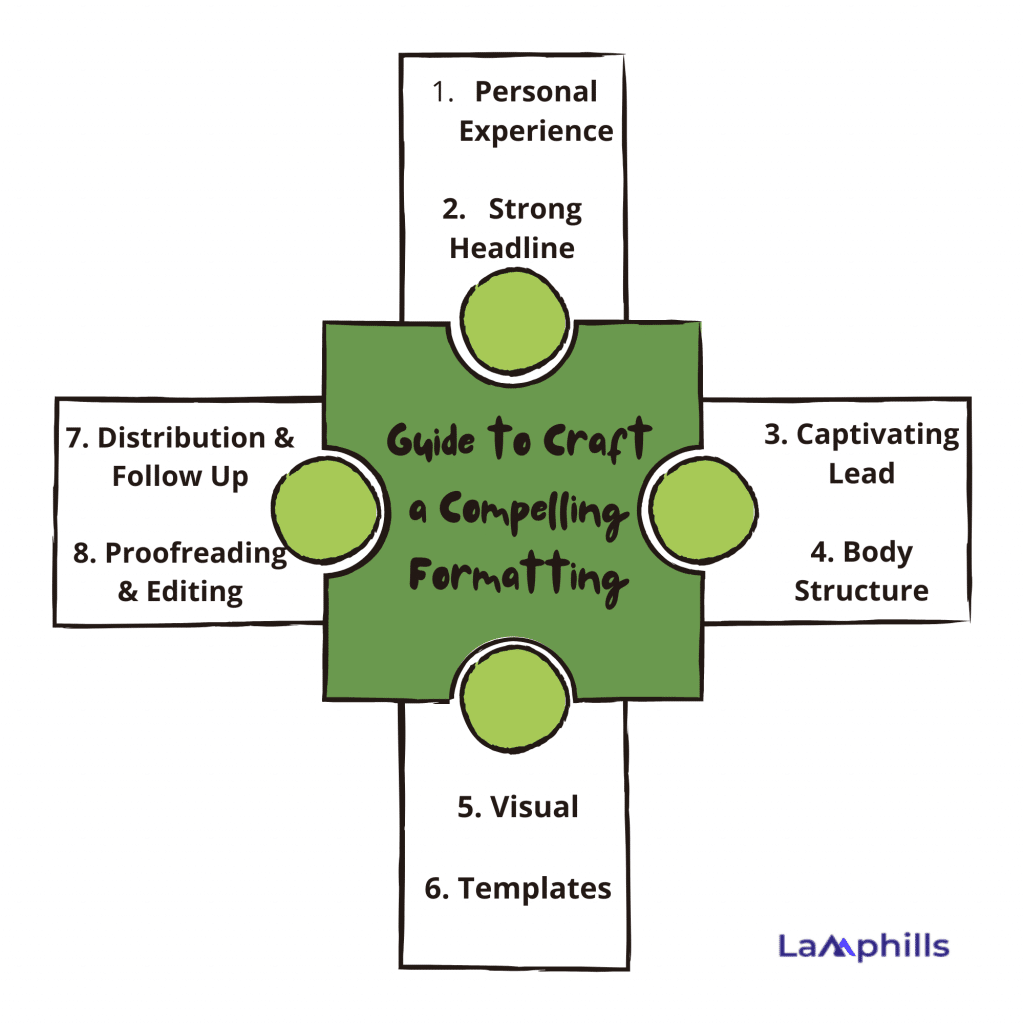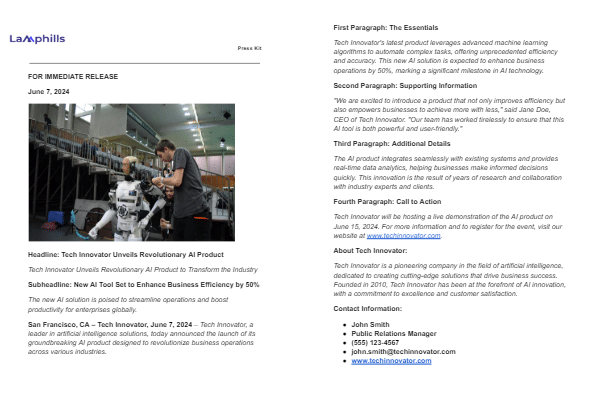Businesses currently need to create their speculation. Clients aren’t waiting for the daily newspaper anymore to get their news. Rather, they are simultaneously skimming the most recent news from several social media platforms. Using press releases to manage the story around your brand is one strategy that can yield maximum results. Press releases are a critical component of public relations. If you’re a business owner, you can’t just expect people to find out about your brand. You have to generate attention yourself, and a great way to do that is with a perfect press release. In this article, I’ll share my tips on how to write the perfect press release, giving my tips on formatting including insights that would help you in your journey as a marketer.
You can tell current and new clients about your business’s objectives and communicate your company’s vision with a perfect press release. I’ve crafted various press releases that have made headlines. The most memorable experience I hold dearly was when I helped a startup client secure a feature in a prominent tech publication. It was a game-changer for their brand, and I was elated to have played a part in it. But what made that press release stand out was not just the content, but the way it was formatted. Let’s get started!
Key Points
- A strong headline is essential as it forms the first impression of the press release. It should be attention-grabbing, concise, and accurately convey the main message.
- Consistency in formatting across different press releases is vital. This includes maintaining a professional image and making it easier for journalists to find and understand the information quickly.
- Proper formatting in a press release is crucial for clarity, readability, and professionalism. A captivating lead or opening paragraph should follow, drawing the reader in and providing context for the rest of the content.
- Using templates can save time and ensure consistency, but it is important to personalize them to reflect the unique style and voice of the company.
Press Release Formatting
In my professional experience, Press release formatting is the structure and layout of a press release document. It involves organizing the content in a way that is easy to read, understand, and navigate for journalists and readers. Writing a press release that effectively communicates your message and grabs the attention of your target audience requires a well-structured format.
Pros of Press Release Formatting
Let’s talk about why press release formatting is important, shall we?
Formatting plays a crucial role in ensuring that your press release is effective and gets the attention it deserves. Here’s why it’s so important:
- Clarity and Readability: Proper formatting helps make your press release easy to read and understand. By using clear headings, paragraphs, and bullet points, you can present your information in a structured and organized manner. This way, journalists and readers can quickly grasp the key details of your news or announcement.
- Professionalism: A well-formatted press release reflects professionalism and attention to detail. It shows that you’ve put effort into presenting your news in a polished and coherent way. This can enhance your credibility and make journalists take your press release more seriously.
- Engagement: Formatting can make your press release more engaging and visually appealing. A catchy headline, subheadings, and bullet points help break up the text and make it easier to scan. This can attract attention and encourage journalists to read your press release in its entirety.
- Consistency: Following a standard press release format ensures consistency across different press releases. This makes it easier for journalists to find the information they need quickly and understand the structure of your press release. It also helps maintain a professional image for your company or organization.
- Journalist-Friendly: Journalists are often busy and receive numerous press releases. Following a standard format makes it easier for them to extract the key information they need. By presenting your news in a clear and organized manner, you increase the likelihood of your press release getting noticed and potentially covered.
Get a Free Download of Lamphill Press Release Formatting Template
Guide to Craft a Compelling Formatting

#1. Personal Experience
First things first, let’s talk about the importance of a personal touch in your press releases. We often get caught up in the formalities and structure of a press release, but using a bit of personality can make all the difference. After all, you want to stand out from the crowd and leave a lasting impression, right?
#2. A Strong Headline
A press release is often the first impression people have of your brand, so it’s crucial to make it count. A strong headline should be attention-grabbing, concise, and accurately convey the main message of the release.
#3. Create Captivating Lead
The lead, or opening paragraph, should draw the reader in and provide context for the rest of the release. It should be engaging, and informative, and set the tone for the rest of the content.
#4. Body Structure
The body of the press release should be well-organized and easy to follow. A common structure should include an introduction, key points that highlight the most important details of the release, a quote from a key figure, such as the CEO or founder and any additional details or context that might be relevant.
#5. Visual
Visuals can make a significant difference in the effectiveness of a press release. Include high-quality images, logos, and other multimedia elements to help bring the story to life. This helps journalists create engaging content and increases the chances of your release being picked up.
#6. Templates
Now, let’s talk templates. Templates can be a lifesaver when it comes to formatting your press release. They provide a solid foundation to build upon, saving you time and ensuring consistency. But don’t rely too heavily on them. Use them as a starting point, and then infuse your unique style and voice to make the press release truly yours. With the Lamphills template, you will be able to provide a perfect press release that suits your brand.
#7. Distribution and Follow-up
Once the press release is written and formatted, it’s time to distribute it to the right channels. This can include sending it to media contacts, posting it on social media, and sharing it through email newsletters. It’s also essential to follow up with media contacts and influencers to ensure they receive the release and to answer any questions they may have.
#8. Proofreading and Editing
Finally, proofread and edit your release carefully to ensure it is error-free and easy to understand. This helps maintain your professional image and ensures your release is taken seriously by journalists.
Let me share some examples and tips that can help you create a professional and effective press release document. When writing, keep the press release concise, it should not be longer than one page. Use a standard business font like Arial or Times New Roman, and single-space the body paragraphs for easy readability.
Here is how a press release formatting would look, you can edit it to fit what you need.
Partnership Press Release

Headline: “Unifonic and PRLab Announce Strategic Partnership to Enhance Communications Services”
Summary: “Unifonic, a leading communications company, has announced a strategic partnership with PRLab to enhance its communications services and expand its global reach.”
Introductory Paragraph: “Unifonic, a leading communications company, has announced a strategic partnership with PRLab to enhance its communications services and expand its global reach.”
Body Content
Key Points: “The partnership aims to leverage the strengths of both companies to provide enhanced communications services and expand global reach.”
Quote: “We’re excited to partner with PRLab to bring our customers the best possible communications experience,” said [CEO’s Name]. “This partnership will enable us to offer a wider range of services and expand our global presence.”
Additional Information: “The partnership will be effective starting [date], and will be marked by a series of joint events and initiatives to promote the partnership.”
Key Practices to Avoid When Formatting a Press Release
- Avoid complex formatting: Stick to a simple, clean format that is easy to read. Avoid using overly complex formatting like multiple font styles, sizes, and colors. This can make the press release look cluttered and unprofessional.
- Don’t use excessive jargon or buzzwords: Use clear, straightforward language that can be easily understood by a general audience. Avoid using too much industry jargon or buzzwords, as this can make the press release seem overly promotional.
- Steer clear of grammatical and spelling errors: Proofread the press release carefully to catch any grammatical or spelling errors. Even minor mistakes can undermine the credibility of the release and the brand.
Get a Free Download of Lamphill Press Release Formatting Template
- Avoid Formatting Inconsistencies: Ensure that the formatting is consistent throughout the press release. This includes things like consistent use of headings, bullet points, and spacing.
- Don’t overuse formatting elements: Different font styles, sizes, and colors can make the press release look cluttered and unprofessional.
- Steer clear of formatting that doesn’t translate well: When copying and pasting from a word processor to an email editor, avoid using formatting that doesn’t translate well. This includes things like complex tables and images with text wrapping.
What are the 7 Parts of a Press Release?
The seven key parts of a press release are the headline, dateline, introduction, body, quotes, boilerplate, and contact information.
- Headline: Craft a catchy and attention-grabbing headline that summarizes the main news or announcement you want to share.
- Dateline: Include the city and date when the press release is being issued. This provides context and timeliness to the news.
- Introduction: Start with an introductory paragraph that provides a concise overview of the news or announcement. This should hook the reader and make them want to continue reading.
- Body: The body of the press release should contain the main details, facts, and key points that support your news or announcement. Use paragraphs or bullet points to break up the information and make it easy to read. Follow the inverted pyramid structure, where the most important information is presented first, followed by supporting details.
- Quotes: Include at least two quotes in the press release, one from the company or organization and another from a third party (e.g., customer, volunteer, attendee). Quotes add credibility and provide different perspectives.
- Boilerplate: Towards the end of the press release, include a boilerplate or “about us” section. This provides background information about the company or organization issuing the press release.
- Contact Information: End the press release with contact information, including a media contact person’s name, email, and phone number. This allows journalists or interested parties to reach out for further information.
How do you Format a Press Release in Word?
To format a press release in Word, you can
- Start with the company logo or header image at the top of the document.
- Include the words “Press Release” or “News Release” at the top left corner.
- Add the release date and location below the company information.
- Write a compelling headline that summarizes the main news or announcement.
- Optionally, include a subheading for additional context or a summary.
- Begin with an introduction paragraph that provides an overview of the press release.
- Use the body of the press release to provide more details, supporting information, and quotes.
- Include relevant facts, figures, and statistics to strengthen your message.
- Consider adding high-quality images, videos, or hyperlinks to enhance the press release.
- End the press release with a boilerplate paragraph that provides background information about the company.
- Use three-centered pound signs (###) at the end to indicate the conclusion of the press release.
- Proofread and edited the press release for clarity, grammar, and formatting consistency.
How do you Style a Press Release?

To style a press release effectively, consider the following tips:
- Eye-catching Headline: Use colors and contrast to make your headline stand out. Ensure it is noticeable and hooks journalists.
- Layout and Formatting: Match your audience’s needs by using a clear structure and formatting. This includes bullet points, tables, and high-quality photos.
- Multimedia: Include multimedia elements like images, logos, and videos to enhance the visual appeal of your press release.
- Press Release Branding: Use consistent branding throughout the release, including logos, fonts, and colors.
- Mobile Optimization: Ensure your press release looks good on both desktop and mobile devices by using a responsive design and avoiding clutter.
- Accessibility: Use clear and simple language, and ensure the release is accessible to people with disabilities by following accessibility guidelines.
- Proofreading: Carefully proofread your press release to catch any grammatical or spelling errors.
- Contact Information: Include your contact information, such as name, email, and phone number, to make it easy for journalists to reach out.
- Standard Format: Follow a standard press release format, including a headline, subheader, dateline, body, quote, company information, and logo.
- Target Audience: Identify your target audience and tailor your press release to their needs and interests.
- Avoid Common Mistakes: Steer clear of common mistakes like overuse of jargon, overly promotional content, and poor formatting.
What Style are Press Releases Written in?
Press releases are written in an objective, journalistic style. Key characteristics of the press release writing style:
- Formal and Professional Tone: Press releases use a formal, professional tone to maintain credibility. The language should be clear, concise, and free of jargon or overly casual phrasing.
- Third-Person Perspective: Press releases are written in the third person, avoiding the use of “I”, “me”, or “we” statements. The focus is on conveying the news objectively.
- Active Voice: Press releases utilize an active voice rather than a passive voice to make the writing more engaging and direct. For example, “Company XYZ launched a new product” rather than “A new product was launched by Company XYZ.”
- Concise and Informative: Press releases aim to communicate the key details of the news or announcement in a clear, concise manner. Sentences should be short and to the point.
- Inverted Pyramid Structure: The most important information is front-loaded at the beginning of the press release, with supporting details following in decreasing order of importance. This mimics the traditional news article structure.
- Factual Reporting: Press releases present the facts of the news or announcement objectively, without excessive hype language. Quotes from company representatives can be used to provide perspective.
Conclusion
Writing the perfect press release takes practice, but it’s a skill that’s well worth developing. By mastering the art of effective formatting, injecting personality, and customizing a proven template, you can create releases that grab attention and drive real results. Remember, it’s all about finding that balance between professionalism and injecting your voice. So go ahead, grab those formatting guidelines, and let your personality shine through.
Related Article
- Media Pitch vs. Press Release: How I Differentiate Them.
- How to Send a Press Release to Local Media (+ Expert Tips)
- Best Free Press Release Distribution Sites for 2024
- 6 Easy Steps to Writing a Press Release BolierPlate (+ Expert Tips)






